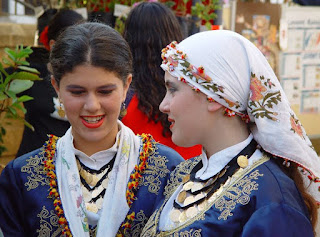Traditional Fashion In Cyprus
Cypriot clothing provided pleasure, beauty, and elegance to people that wear it. Cypriot costumes, like Cyprus's traditional art in general, have a touch of conservative style nature, however, variation and elegance are not lacking. Each costume is a sophisticated piece of art that incorporates numerous weaving techniques and ornamentation, as well as the expertise of its makers. Due to the obvious confined geographical region, Though the traditional wearing of Cyprus has reflections of Greece.
Cyprus Girls Traditional Wears
The unmarried girls all wore a dark headband (in Morfou, it was an olive shade), and the little girls wore silk, embroidered forehead bands adorned with organic or inorganic flowers. On official occasions, in the church, and at marriages, a white vail -typically fashioned of silk- was generally carried the headband on their head, and its border was usually stitched with golden or silver embroidery, with multicoloured bangs. The woman wore her dark-red fez only on special occasions. The dark purple 'tsemperia' (headscarves) that we know today were exclusively worn by elderly ladies who were not in mourning, and not by children. The aprons were not a regular part of the Cypriot woman's attire.
Cyprus Women Traditional WeaWears
Cyprus women used to wear the dress called "sayia" which was a dress with openings in the front and sides that ladies wore until the nineteenth century and "the urban": a broad silk shirt, a quarter sleeves jacket, as well as a fez or shawl, are examples of traditional Cypriot women's attire. was also carried within the dress. Women wore lengthy undergarments that reached the soles of their feet. Due to the extremely traditional way of life, ladies in the past had to cover their entire bodies. The undergarments were embroidered along the borders. (From the calf of the leg to the ankle.) The presence of'sarka' in'sayia' kind of costume, Cyprus's oldest women's costume, calls into consideration those who believe that'sarka' was introduced to Cyprus during the reign of Queen Amalia of Greece. What has happened is that towns-cities were changed and became urban at some time. The ultimate shape of the 'urban sarka' may have been influenced by fashion influences from overseas, as it has persisted in its pure source in the districts of Karpasia and Pafos.
Cyprus men Traditional Wear
Traditional clothing for men in Cyprus includes silk shirts, waistcoats known as "zimbouni," loose cotton pants named "vraka," and they wear this dress with woven belts with buckles are called "zoster," fez caps, shoes and socks, and some form of outfits.
Traditionally, shirts are made of silk, especially for important occasions. Cotton and other less expensive materials can also be used for everyday shirts. The original Cypriot shirts were used to stiched without collars, but individuals subsequently began to add collars.
Has Cyprus Traditional Clothings Changed?
Citizens of Cyprus who are known as Cypriots, just after 2015 started to prefer to wear apparel that was deemed modern, such as jeans, t-shirts, cotton leggings for women, and slim body fitted suits for professionals. Except when attending weddings or festivities, Now Cypriots rarely wear traditional clothes.
Reference:
https://vasilitzia.org.cy/en/the-traditional-cypriot-garment-dress-code/
https://www.reference.com/world-view/people-cyprus-wear-84a85155a53655cc








No comments:
Post a Comment